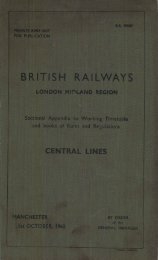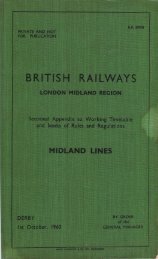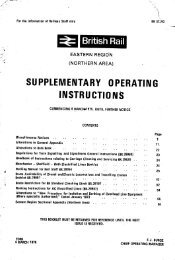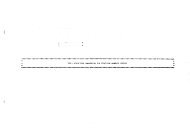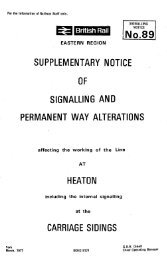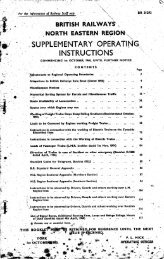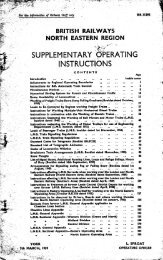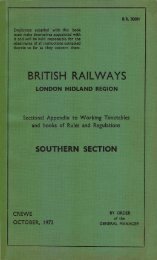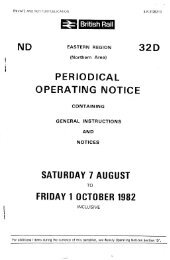general instructions. - Limit Of Shunt
general instructions. - Limit Of Shunt
general instructions. - Limit Of Shunt
Create successful ePaper yourself
Turn your PDF publications into a flip-book with our unique Google optimized e-Paper software.
Special Instructions applicable at Particular Places.—Continued. 217<br />
LEEDS.—WORKING OF TRAFFIC BETWEEN NEVILLE HILL<br />
SIDINGS AND HUNSLET GOODS YARD.<br />
More than one engine or train may be allowed on the branch at one time,<br />
the following <strong>instructions</strong> being observed :—<br />
1<br />
Yard, ; shewing the point at which the drivers must stop, and during<br />
darkness<br />
-<br />
a red light will be shewn at this point.<br />
-2.—The<br />
first train or light engine entering the branch in the morning<br />
must do so on the understanding that the line is only clear to the " Stop<br />
A<br />
board opposite the shunters' box, and the driver must not go beyond this<br />
board " until he receives <strong>instructions</strong> from the guard who must first receive<br />
the Sauthority<br />
of the shunter. In the case of a light engine, the driver will<br />
receive t <strong>instructions</strong> from the shunter direct.<br />
3.—When o a second train or engine requires to enter the branch, the<br />
signalman p at Neville Hill box will verbally inform the driver that a train<br />
or<br />
"<br />
engine is already in the Hunslet Yard, and that he must go cautiously<br />
forward, as the line is only clear to the " Stop" board referred to.<br />
b<br />
4.--In<br />
o<br />
foggy weather the Goods Yard <strong>Shunt</strong>er must place one detonator<br />
opposite the depots, on the Down line, to warn drivers of Down trains<br />
when<br />
a<br />
they are approaching the point at which the train must be brought<br />
to ra<br />
stand.<br />
6.--A d red light is fixed at the dead end of the Down line to indicate to<br />
drivers i where the chock is.<br />
Automatic s levers have been fixed at the undermentioned points<br />
f (a) From the incoming road to the Wagon Shops Storage Siding.<br />
i (b) From the incoming road to the Wagon Shops Siding.<br />
x (c) From the incoming road to the Manure Dock.<br />
e (d) From the incoming road to the Coal Lines.<br />
(e) Two levers in connection with the line leading into and out of<br />
d<br />
the Exchange Sidings. ( 0 . 6409).<br />
o<br />
p<br />
COUPLING OF ENGINES BETWEEN WATERLOO JUNCTION<br />
p<br />
AND LEEDS EAST BOXES.<br />
o<br />
Six s engines coupled together are allowed to run between Waterloo Junction<br />
and Leeds East Signal boxes.<br />
i<br />
t When three engines are coupled together the leading engine only must<br />
use e steam, the other two being hauled by it, but when more than this<br />
number<br />
t<br />
are coupled, the first two engines must use steam in order to<br />
haul the remainder. ( O . 7416.)<br />
h<br />
e<br />
LEEDS.----WAGONS FOR MARSH LANE CONVEYED BY TRAINS<br />
s<br />
STARTING FROM LEEDS (WELLINGTON STREET) OR<br />
h HUNSLET SIDING, AND RUNNING IN THE<br />
u<br />
DIRECTION OF NEVILLE HILL.<br />
n<br />
When a train, running as above, has on wagons ticketed to Marsh Lane<br />
Station,<br />
t<br />
the guard must instruct the driver to stop at Marsh Lane to detach<br />
them e there, instead of taking them through to Neville Hill Sidings.<br />
r<br />
Wagons<br />
s<br />
should, however, be sent by booked trains as far as practicable.<br />
'<br />
b<br />
o<br />
x<br />
i




